Guide to Long-Term Upkeep for Your Newly Renovated Home
Guide to Long-Term Upkeep for Your Newly Renovated Home
Maintaining a newly renovated home requires a strategic approach to ensure longevity and preserve the quality of the upgrades.
Implementing regular maintenance routines and promptly addressing potential issues allows homeowners to protect their investment and enhance their living spaces' functionality and aesthetic appeal.
This guide provides homeowners with expert advice on key maintenance practices, preventive measures, and seasonal upkeep strategies to protect the integrity of their home improvements.
Best Practices for Maintaining the Quality of New Materials
Budgeting for ongoing care is essential for maintaining the quality of new materials in a home. The chart below highlights the spending priorities for households in the lowest income quintile (homeowners earning below $32,000).
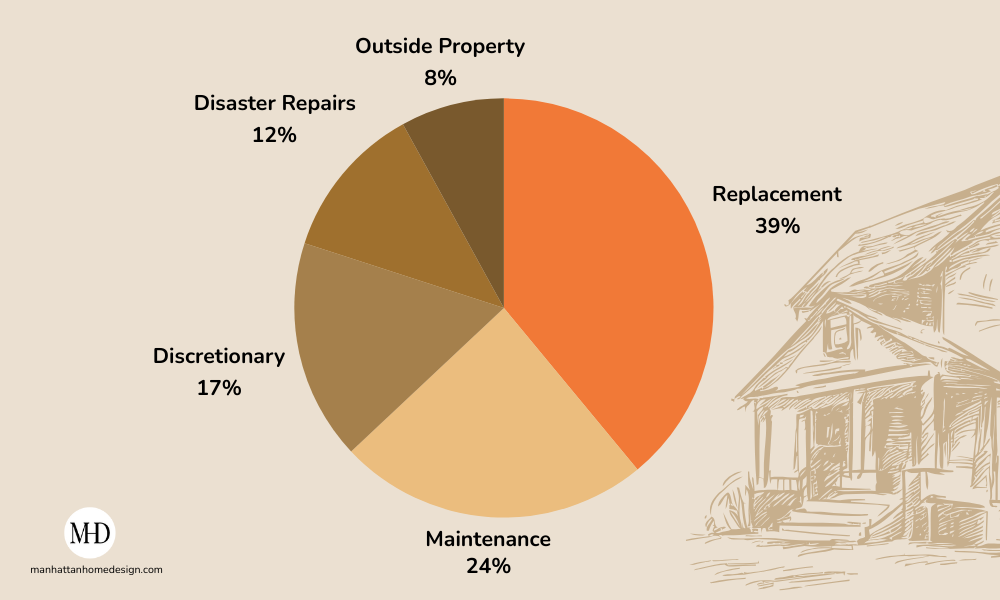
According to the Joint Center for Housing Studies of Harvard University, most homeowners allocate a high portion of their income to key areas such as maintenance (24%) and replacement (39%).
Recognizing these spending habits allows homeowners to allocate funds more effectively toward preventive measures, which ultimately prolongs the lifespan of their upgrades and minimizes long-term costs. To support this approach, the following guidelines offer a structured method for effective home material maintenance:
Cleaning and Care
Different materials require tailored cleaning methods to prevent damage and maintain their integrity. For instance, hardwood floors should be cleaned with a damp mop and a pH-neutral cleaner to avoid warping or discoloration. In contrast, natural stone surfaces benefit from a mild detergent and water solution, avoiding acidic or abrasive cleaners that can etch the surface.
Use of Recommended Products
Manufacturers often provide specific recommendations for cleaning and maintenance products. Adhering to these guidelines is key, as using inappropriate products can void warranties and lead to premature wear. For example, using a silicone-based polish on wood can create a buildup that attracts dust and dirt, whereas a water-based polish is typically recommended.
Preventive Measures
Implementing preventive measures can significantly extend the lifespan of materials. For instance, using felt pads under furniture legs can prevent scratches on flooring, while applying a sealant to stone countertops can protect against stains and moisture penetration.
Regular Inspections
Conducting regular inspections allows for the early detection of potential issues such as cracks, chips, or discoloration. Addressing these issues promptly can prevent further deterioration.
Environmental Considerations
Environmental factors such as humidity, temperature, and exposure to sunlight can affect material quality. For example, using UV-protective films on windows can reduce the fading of fabrics and wood finishes.
Education and Training
Homeowners should educate themselves on the specific maintenance needs of their materials. This can involve consulting with professionals or attending workshops.
The Frequency for Scheduling Professional Inspections
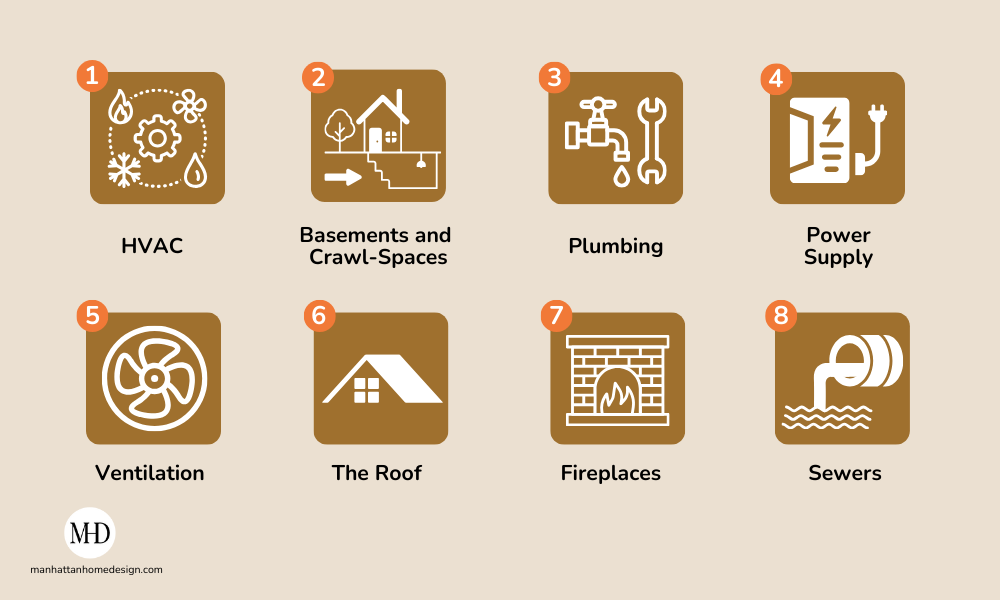
Scheduling professional inspections for a newly renovated home is a key component of maintaining the integrity and longevity of the renovations. The following general guidelines can be established to ensure comprehensive maintenance:
Initial Post-Renovation Inspection
It is advisable to conduct an initial inspection within the first six months following the completion of renovations. This inspection should focus on identifying any immediate issues that may have arisen post-construction, such as settling of materials or minor defects.
Annual Inspections
For most homes, an annual inspection is recommended. This allows for the early detection of potential problems, such as structural issues, water damage, or wear and tear on materials.
Specialized Inspections
Certain elements of a home may require more frequent inspections. For example, HVAC systems should be inspected bi-annually to ensure optimal performance and energy efficiency.
Climate-Specific Inspections
Homes located in areas with extreme weather conditions may require more frequent inspections. For instance, properties in hurricane-prone regions should have their roofing and structural integrity assessed before and after the storm season.
Material-Specific Inspections
The materials used in renovations can also dictate inspection frequency. For example, natural wood elements may require more regular checks for signs of moisture damage or pest infestation.
Caring for Newly Installed Flooring
Ensuring the longevity and aesthetic appeal of newly installed flooring requires adopting a systematic approach to maintenance that considers the specific material properties and environmental factors. Here are distinct care protocols for different flooring materials:
Hardwood Floors
|
Regular cleaning with a microfiber mop is recommended to remove dust and debris without scratching the surface. It is advisable to use a pH-neutral cleaner specifically formulated for wood to avoid chemical damage. Additionally, placing protective pads under furniture can mitigate the risk of scratches and dents. |
Laminate Flooring
|
While more resistant to wear, still necessitates careful maintenance. It is important to avoid excessive moisture, as water can seep into seams and cause swelling. A damp mop with a laminate-safe cleaner is sufficient for routine cleaning. |
Tile Flooring |
Regular sweeping and mopping are required to prevent grout discoloration and surface wear. A mild detergent mixed with warm water is effective for cleaning tiles. Sealing grout lines every 1-2 years can prevent moisture penetration and staining. |
Carpet Maintenance
|
Involves frequent vacuuming to remove dirt and allergens that can degrade fibers. Professional deep cleaning is recommended annually to maintain the carpet's appearance and hygiene. |
Best Ways to Maintain New Kitchen and Bathroom Fixtures
Maintaining new kitchen and bathroom fixtures is essential to preserving their functionality and aesthetic appeal. Proper care involves the following key steps to ensure longevity and optimal performance:
Preventive Care
Drying fixtures after use is essential to prevent water spots and stains. Water spots are primarily caused by mineral deposits left behind when water evaporates. Wiping down fixtures with a soft, lint-free cloth can reduce the occurrence of these spots.
Additionally, installing water softeners can help minimize mineral buildup, as hard water is a common cause of staining.
Cleaning Tips
When selecting cleaning products, it is important to choose those that are non-abrasive and specifically formulated for the materials of your fixtures. Abrasive cleaners can scratch surfaces, leading to dullness and potential damage.
For example, chrome fixtures benefit from mild soap solutions, while vinegar-based solutions can effectively clean stainless steel. Bleach and ammonia-based products should be avoided, as they can corrode metal finishes over time.
Leak Inspections
Regular inspections for leaks or other issues are vital. If left unaddressed, leaks waste water and can cause significant damage.
The U.S. Environmental Protection Agency (EPA) estimates household leaks can waste nearly 10,000 gallons of water annually. Checking for leaks involves examining connections and seals around faucets, showerheads, and toilets. Replacing worn-out washers and seals promptly can prevent leaks and maintain the integrity of the fixtures.
Proper Maintenance for Exterior Renovations like Siding and Roofing
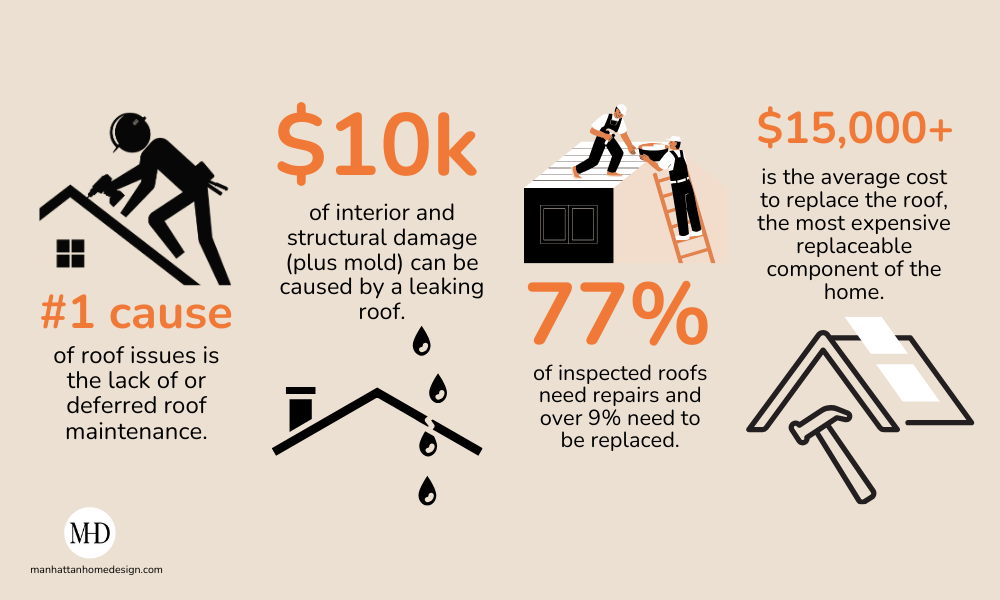
Maintaining exterior renovations such as siding and roofing preserves a newly renovated home's structural integrity and aesthetic appeal. According to the National Roof Certification & Inspection Association, the number one cause of roof issues is lack of or deferred roof maintenance.
Proper maintenance extends the lifespan and prevents costly repairs. Here are key considerations and practices for maintaining siding and roofing:
Regular Inspections
Regular roof inspections should be conducted biannually, ideally in the spring and fall, to identify and address potential issues before they escalate. During these inspections, attention should be paid to the condition of shingles or tiles, ensuring they are intact and securely fastened.
Any signs of curling, cracking, or missing shingles should be promptly addressed to prevent water infiltration and subsequent structural damage.
Cleaning
Siding should be cleaned at least once a year to remove dirt, mold, and mildew. Use a mild detergent, soft brush, or pressure washer on a low setting to avoid damage.
Gutter systems play a key role in roof preservation by directing water away from the structure. Clogged gutters can cause water to back up under the roof, leading to leaks and water damage. Therefore, gutters should be cleaned regularly, particularly after fall, when leaves and debris are most prevalent.
Moisture Management
Ensure that gutters and downspouts are clear and functioning properly to direct water away from the home. This prevents water from seeping into the siding or roofing materials, which can cause deterioration.
The presence of moss, algae, or lichen on the roof surface can accelerate deterioration. These organisms retain moisture, which can lead to rot and decay. Applying a zinc or copper-based algaecide can effectively inhibit their growth.
Additionally, trimming overhanging branches can reduce shade and moisture retention, further mitigating the risk of moss and algae proliferation.
Repairs and Replacements
Flashing, the material used to seal joints and prevent water penetration, should be inspected for signs of rust, cracks, or separation. Damaged flashing can compromise the roof's waterproofing capabilities, necessitating immediate repair or replacement.
Address any minor repairs immediately to prevent them from becoming major issues. Replace damaged siding panels or shingles promptly. Use materials that match the existing ones to maintain the uniformity and integrity of the exterior.
Protective Coatings
Consider applying protective coatings to siding and roofing materials. These coatings can provide additional resistance to UV rays, moisture, and temperature fluctuations.
Ventilation and Insulation
Ensure that the attic and roof are properly ventilated and insulated. Adequate ventilation prevents heat and moisture buildup, which can damage roofing materials. Insulation helps maintain energy efficiency and reduces the risk of ice dams in colder climates.
Professional Maintenance
Engage professional services for maintenance tasks that require specialized skills or equipment. Professionals can provide thorough inspections and perform complex repairs that are beyond the scope of typical homeowner maintenance.
Steps to Avoid Mold and Mildew
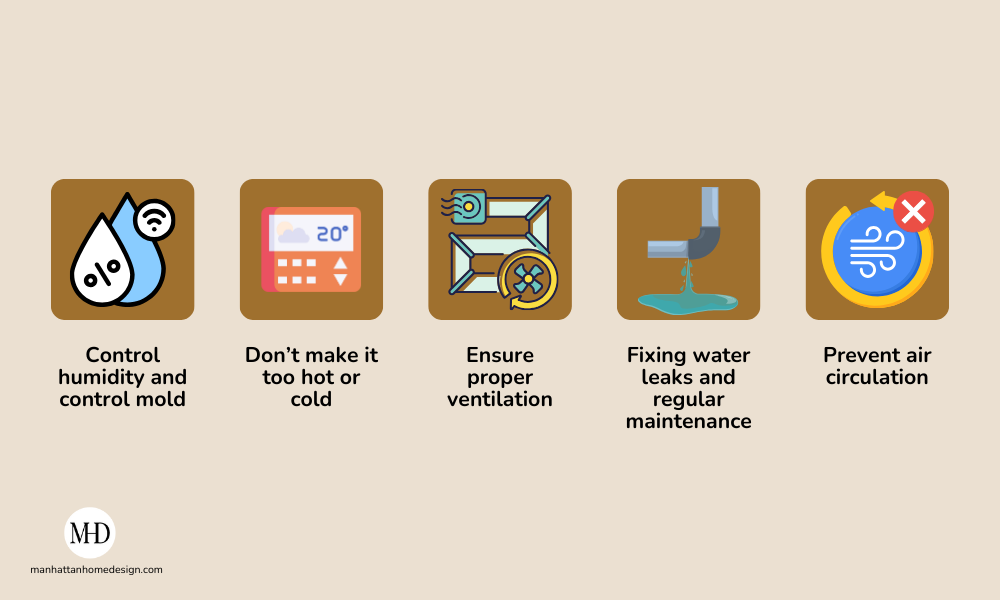
Preventing mold and mildew in a newly renovated home involves adopting several essential measures tailored to the conditions that facilitate their growth.
Mold and mildew thrive in environments with moisture, warmth, and organic material. To combat this, consider the following steps:
Control Humidity Levels
Maintaining indoor humidity levels below 60% is advised, as mold growth is significantly reduced in drier environments. Dehumidifiers can be effective in areas prone to moisture accumulation, such as basements and bathrooms.
Ensure Adequate Ventilation
Proper ventilation is vital in areas with high moisture levels, such as kitchens, bathrooms, and laundry rooms. Installing exhaust fans and ensuring they are vented to the outside can help remove excess moisture from the air. Opening windows and doors to allow air circulation can further reduce humidity levels.
Address Water Leaks Promptly
Water leaks from plumbing fixtures, roofs, or windows can create ideal conditions for mold growth. It is imperative to inspect these areas regularly and address any leaks immediately.
The Insurance Information Institute reports that approximately one out of every 60 homes files a claim for property damage resulting from water damage or freezing. Addressing water leaks immediately can protect your home from further damage.
This graph displays the average amount of insurance claims for different types of property and liability losses.
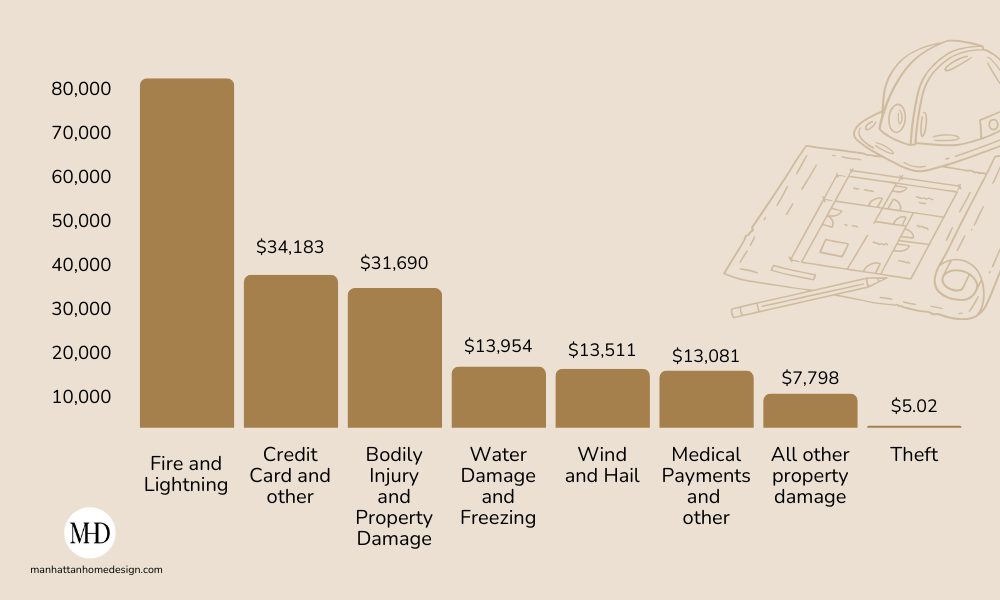
This graph highlights the importance of home maintenance after renovations, particularly in preventing costly damages. Fire and lightning, which have the highest average claim costs at over $80,000, emphasize the need for installing fire safety measures, such as smoke detectors and surge protectors.
Similarly, water damage, freezing, wind, and hail, with claims around $13,000 each, show the value of keeping your roof, gutters, and plumbing in good condition to avoid these common post-renovation issues.
Regular maintenance could reduce the risk of these high-cost repairs, keeping your newly renovated home in top shape for years to come.
Use Mold-Resistant Products
During renovations, consider using mold-resistant drywall, paint, and insulation in areas susceptible to moisture. These products are designed to inhibit mold growth and can provide an additional layer of protection.
Regular Cleaning and Maintenance
Regular cleaning of surfaces with mold-inhibiting solutions can prevent mold spores from taking hold. It is also important to clean and maintain HVAC systems, as they can distribute mold spores throughout the home if not properly maintained.
Monitor and Manage Condensation
Condensation on windows, walls, and pipes can lead to mold growth. To reduce condensation, consider insulating pipes and installing double-glazed windows. Regularly wiping down surfaces where condensation forms can also help p revent moisture buildup and minimize the risk of mold.
Zames Chew, Co-Founder of Repairs.sg, a home repair, installation, and maintenance business in Singapore, states:
“Living in a climate that fluctuates between high humidity and substantial rainfall can create the perfect breeding ground for mold in your home. Installing a dehumidifier in high-moisture areas such as bathrooms, kitchens, and basements is an effective way to keep mold at bay.”
Preventing Wear and Tear in High-Traffic Areas
High-traffic areas, such as entryways, hallways, and living spaces, are subject to increased stress due to frequent use. key actions to consider to prolong the lifespan of high-traffic areas include:
Material Selection
The choice of materials plays an important role in minimizing wear and tear. Durable materials such as ceramic tiles, hardwood with a high Janka hardness rating, and high-quality laminates are recommended for high-traffic areas. These materials are engineered to withstand significant foot traffic and resist surface damage.
Protective Measures
Implementing protective measures can significantly reduce the impact of daily use. Area rugs and runners can be strategically placed in high-traffic zones to absorb the impact of foot traffic and prevent direct contact with flooring surfaces.
Additionally, furniture pads should be used under heavy furniture to prevent scratches and indentations.
Regular Maintenance
Consistent maintenance is key to preserving the integrity of high-traffic areas. This includes routine cleaning to remove dirt and debris that can cause abrasion.
For flooring, a vacuum with a soft brush attachment or a microfiber mop is recommended to prevent surface scratches.
Preventive Strategies
Implementing preventive strategies can further mitigate wear and tear. Encouraging the removal of shoes at entry points can significantly reduce the introduction of abrasive particles.
Additionally, installing door mats at entrances can capture dirt and moisture, preventing them from being tracked into the home.
Periodic Inspections
Conducting periodic inspections allows for the early detection of wear and tear, enabling timely interventions. Inspections should focus on identifying signs of damage, such as scratches, dents, or fading. Addressing these issues promptly can prevent further deterioration and maintain the aesthetic quality of the surfaces.
Tips for Preparing Your Home for Winter
Proper winter preparation can reduce energy costs and prevent damage, contributing to the long-term upkeep of the home. Key winter maintenance tasks include:
Insulation and Sealing
Ensuring your home is well-insulated is important for maintaining a stable indoor temperature. Inspect the attic, walls, and floors to ensure adequate insulation. Additionally, seal any gaps or cracks around windows, doors, and other openings to prevent unnecessary heat loss.
Heating System Maintenance
Before the onset of winter, have a professional inspect and service the heating system. This includes cleaning or replacing filters, checking for leaks, and ensuring that the system operates efficiently.
Pipe Protection
Insulate exposed pipes in unheated areas such as basements, attics, and garages to prevent freezing, which can cause bursts and water damage. Additionally, installing heat tape or thermostatically controlled heat cables provides extra protection.
Roof and Gutter Inspection
Inspect the roof for damaged or missing shingles and repair them to prevent leaks. Clean gutters and downspouts to ensure proper drainage and prevent ice dams, which can cause structural damage.
Ice dams, which form when snow melts and refreezes at the roof's edge, can cause significant damage. It is essential to ensure that the attic is properly insulated and ventilated to prevent ice dams. This helps maintain a consistent roof temperature, reducing the likelihood of snowmelt.
Window and Door Efficiency
Install storm windows and doors to provide an additional layer of insulation. If storm windows are not available, consider using window insulation film to reduce heat loss.
Chimney and Fireplace Preparation
If the home has a fireplace, have the chimney inspected and cleaned by a professional to remove creosote buildup, which is a fire hazard. Ensure the damper is functioning correctly to prevent drafts when the fireplace is not in use.
Exterior Maintenance
Trim tree branches that could fall on the house during a storm. Check exterior lighting and replace any burnt-out bulbs to ensure pathways are well-lit and safe during shorter daylight hours.
Essential Tasks for Spring and Summer Upkeep
Spring and summer present unique opportunities and challenges for maintaining a newly renovated home. As temperatures rise and the environment changes, homeowners must adapt their maintenance strategies to ensure the longevity and efficiency of their home systems.
The following tasks are essential for effective spring and summer upkeep:
HVAC System Maintenance
|
It is important to inspect and service HVAC systems to ensure optimal performance. According to Energy Star, an HVAC system air filter should be replaced at least once every three months. When the filter is dirty, it reduces airflow, causing the system to work harder to maintain a comfortable temperature, which increases energy consumption. |
Roof and Gutter Inspection
|
Spring is an ideal time to inspect the roof for any damage that may have occurred during winter. Look for missing or damaged shingles and ensure gutters are clear of debris to prevent water damage. |
Exterior Cleaning and Sealing
|
The home's exterior, including siding, decks, and patios, should be cleaned to remove dirt, mold, and mildew. Applying a sealant to wooden structures can protect against moisture and UVdamage. |
Pest Control Measures
|
Warmer weather can increase pest activity. Preventive measures such as sealing entry points, maintaining clean outdoor areas, and using environmentally friendly pest control solutions can mitigate infestations. |
Theresa Gilbride, a researcher at the Pacific Northwest National Laboratory, emphasizes that:
“If your HVAC ducts run through the attic, have a professional check that the HVAC ducts are well sealed to prevent air leakage and well insulated to prevent heat transfer. Leaky or poorly insulated ducts can be a big source of cooling loss in the summer and heating loss in the winter. And that leads to uncomfortable conditions and higher energy bills.”
Steps to Take if You Notice Defects or Damage Post Renovation
If defects or damage are observed post-renovation, it is imperative to address these issues promptly to prevent further deterioration and to ensure the longevity of the renovation work. The following steps outline a systematic approach to managing such situations:
Documentation
Begin by thoroughly documenting the defects or damage. This should include taking high-resolution photographs and detailed notes describing the nature and extent of the issues. Documentation serves as a key record that can be used in communications with contractors or for insurance purposes.
Review Contractual Agreements
Examine the original renovation contract to understand the warranty terms and conditions. Most renovation contracts include a warranty period during which the contractor is responsible for addressing defects.
Contact the Contractor
Communicate the issues to the contractor who performed the renovation. Provide them with the documented evidence and request a site visit to assess the situation. It is advisable to communicate in writing to maintain a clear record of all interactions.
Assessment and Resolution
During the contractor's site visit, discuss potential causes and solutions for the defects or damage. Contractors are typically obligated to rectify issues that arise from workmanship errors or material failures within the warranty period.
Independent Evaluation
If the contractor disputes the claim or if the issue is not resolved satisfactorily, consider hiring an independent inspector or structural engineer to evaluate the defects. An independent assessment can provide an unbiased opinion and may be necessary for further negotiations or legal proceedings.
Legal Recourse
Legal action may be necessary if the contractor fails to address the defects. Consult with a legal professional specializing in construction law to explore options such as mediation, arbitration, or litigation.
Insurance Claims
If the damage is extensive and not covered by the contractor's warranty, consider filing a claim with your homeowner's insurance. Review your policy to understand coverage limits and exclusions related to renovation work.
Examples of Post-Renovation Success With Moisture Prevention and Regular Home Care
A successful home renovation doesn’t end once construction is complete. It extends into the ongoing care and maintenance of your newly transformed space.
Here are two case studies that highlight how proactive inspections and moisture management strategies can contribute to the long-lasting preservation of a renovated home.
Maintaining a Renovated Home Through Moisture Control and Maintenance
A family carrying out home renovations installed high-quality ventilation systems as part of their post-renovation plan to improve air circulation and prevent condensation build-up.
The family also regularly inspected their home’s foundation, plumbing, and window seals to ensure no signs of leaks or moisture.
After implementing regular maintenance checks, including cleaning and monitoring the HVAC systems, the homeowners successfully controlled indoor humidity levels and kept their living environment comfortable and safe for over five years. No major repairs or unexpected mold outbreaks were reported during this period.
This case highlights how proper moisture management, proactive inspections, and a maintenance routine are vital for preventing mold growth in a newly renovated home.
Preserving a Renovated Home With Proactive Maintenance and Care
In January 2019, a homeowner completed a renovation of their 1920s craftsman-style home, focusing on modernizing the roof, repairing the windows, and updating the wood siding.
The first task in the homeowner's maintenance routine involved regular roof checks. Every spring and fall, the roof was inspected for signs of damage, such as loose shingles or defective flashing.
In addition to the roof, the home's restored wood siding was treated every three years in accordance with the guide's recommendations, which advised applying a new coat of protective stain to prevent damage from weather and moisture.
Due to diligent maintenance efforts, the home looked as pristine as it had on the day of the renovation by 2024. The homeowner’s commitment to following a long-term maintenance schedule proved highly successful, preserving the modern updates and the classic aesthetic of the home for the long term while avoiding expensive emergency repairs.
Ways to Find Reliable Professionals for Repairs
To find reliable professionals for repairs in a newly renovated home, it is essential to employ a systematic approach that ensures quality and accountability. The following steps outline a comprehensive method for selecting qualified repair professionals:
Research and Verification
Begin by compiling a list of potential professionals through recommendations from trusted sources, such as friends, family, or online reviews. Verify their credentials by checking licenses and certifications often required by state or local regulations.
Evaluate Experience and Expertise
Assess each candidate's experience level by reviewing their portfolio of past projects. Look for professionals who have specific experience with the type of repair needed.
Check References and Reviews
Request references from previous clients and contact them to inquire about their experiences. Online platforms such as the Better Business Bureau and Angie's List can provide additional insights through customer reviews and ratings.
Conduct Interviews
Arrange interviews with shortlisted professionals to discuss the scope of work, timelines, and costs. During the interview, assess their communication skills and willingness to answer questions. Effective communication is crucial for successful project execution.
Obtain Multiple Quotes
Request detailed quotes from at least three professionals to compare pricing and services. Ensure each quote includes a breakdown of labor, materials, and additional fees. This comparison will help identify any outliers and ensure competitive pricing.
Review Contracts Thoroughly
Before finalizing any agreement, carefully review the contract terms, including payment schedules, warranties, and dispute resolution processes. A well-drafted contract protects both parties and sets clear expectations.
Monitor Work Progress
Once a professional is hired, maintain regular communication and monitor the progress of the repair work. This oversight ensures that the project stays on track and any issues are addressed promptly.
The Financial Strain of Home Upkeep
Maintaining a newly renovated home can be financially challenging, especially for lower-income homeowners. Here is a bar chart illustrating the relationship between homeowners' income levels and the share of their income spent on home improvement and maintenance projects.
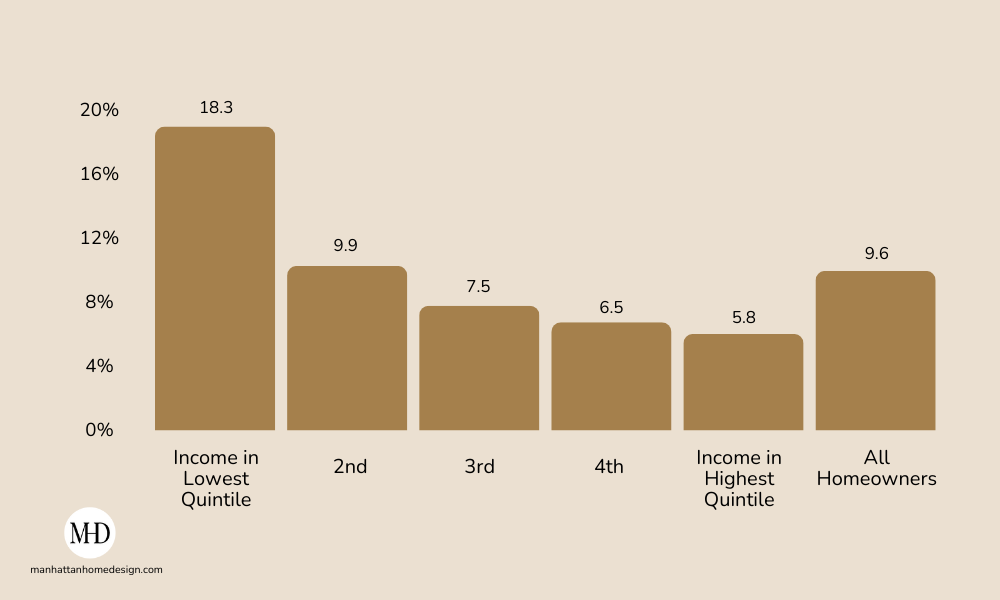
According to Joint Centers for Housing Studies of Havard University, homeowners in the lowest income quintile spend around 18.3% of income on maintenance, while those in the highest income bracket spend only about 5.8%. This stark contrast highlights a financial strain for lower-income households, who must allocate more of their limited resources to care for their homes.
Focusing on smaller, essential tasks like sealing cracks and maintaining systems can help lower-income homeowners manage upkeep without overspending. Additionally, learning basic DIY maintenance skills can be a valuable way to save on labor costs.
In contrast, higher-income homeowners may be more inclined to hire professionals for routine home care, thanks to their smaller financial burden relative to their income.
Nonetheless, a carefully planned maintenance schedule is essential for all homeowners, as long-term care will directly impact the condition and value of the home over time.
Prioritize Long-Term Care for Your Renovated Home
A renovated home is a joy to live in, but its lasting value depends on a diligent approach to ongoing maintenance.
Regular upkeep, preventive strategies, and early identification of potential issues are essential to preserving the quality and functionality of your upgraded spaces.
Don’t wait for wear to set in. Take action now! Embrace a long-term maintenance routine to ensure your renovated home remains a place of beauty and comfort for years ahead.
References
- Fix a Leak Week | US EPA. (n.d.). Environmental Protection Agency (EPA). Retrieved October 28, 2024, from https://www.epa.gov/watersense/fix-leak-week
- Facts + Statistics: Homeowners and renters insurance | III. (n.d.). Insurance Information Institute. Retrieved October 28, 2024, from https://www.iii.org/fact-statistic/facts-statisti...
- Heat & Cool Efficiently | ENERGY STAR. (n.d.). Energy Star. Retrieved October 28, 2024, from https://www.energystar.gov/saveathome/heating-coo...
- Preventing Mold-Related Problems in the Indoor Workplace. (n.d.). OSHA. Retrieved October 28, 2024, from https://www.osha.gov/sites/default/files/publicat...
- Maintaining Your Historic Home: A Practical Guide for Homeowners. (n.d.). Delaware County. Retrieved October 28, 2024, from https://www.delcopa.gov/planning/pubs/Maintaining...















